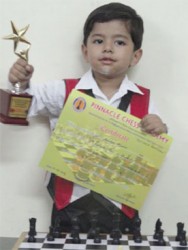Israel’s Boris Gelfand has won the Tal Memorial ahead of Carlsen, who placed second, and world champion Vishy Anand who finished almost at the bottom of the table. The ten participants were almost evenly matched in terms of rating points, with the exception of course being Carlsen, who is the only person who has reached, and surpassed the 2800 mark.

Younger and younger people are taking up chess, perhaps only as a pastime. But parents are recognizing that chess helps the young mind to concentrate. Consider Sparsh Bisht, a four-year-old player from Gurgaon, India. Born in May 2009 Sparsh has already competed in two national tournaments. He began playing last November when he was three years and ten months of age. He learnt the game from his father, taking one week to comprehend how the pieces move.
In the state level tournament at which Sparsh was a participant in Gurgaon, he was awarded the second position in the Under-7 championship, winning five out of six games. Playing in the Indian chess nationals in Chennai, Sparsh was the youngest to emerge in the top twenty, but not the youngest to participate. There was a kid who was 24 days younger than Sparsh!

The Times of India has reported that Sparsh is already in the habit of solving chess puzzles from Sergey Ivashchenko’s Manual of Chess Combinations. He has a chess coach, reserving the weekends for chess training. His parents want him to become the youngest rated player in the world. According to the Times of India, the current record is held by a kid from Bombay who was four years and nine months old when he was officially rated. Sparsh still has about eight months to go.
On the local chess scene…
The Trophy Stall seven round swiss tournament begins this morning at 10 am at the Carifesta Sports Complex.
A number of youths are expected to participate in keeping with the trend where for the past year, the juniors have been outnumbering the seniors in tournaments.
Chess players are encouraged to become members of the Guyana Chess Federation. Contact can be made with President Shiv Nandalall on 225 8270. All members of the GCF will pay a reduced participation fee for today’s tournament. Two rounds will be played today, and two rounds tomorrow. The tournament continues on Thurs-day evening and concludes next Sunday.
Flamberg v Levitsky
The Polish master Alexander Flamberg was a gifted player with original ideas. Ill health prevented him from asserting his full powers over the chessboard. Here is one of his notable games.
His countryman Przepiorka commented as follows: “When one examines the opening moves and the subsequent course of the game, it is almost incredible that it was played in 1914… the double fianchetto of the bishops, the operations on both wings and later on the manoeuvres with the black knights and the posting the queen on the long diagonal ‒ all these ideas are considered the achievements of the hypermoderns.’’ However, by calling the game one of the most significant in the history of chess is truly an exaggeration, but the play is certainly an illustration of hypermodern tenets.
Alexander Flamberg – Stepan Mikhailovich Levitzky
All-Russian Masters’ Tournament, St Petersburg, 16 January 1914 Queen’s Indian Defence
1 d4 Nf6 2 Nf3 b6 3 g3 Bb7 4 Bg2 e6 5 O-O Be7 6 b3 O-O 7 Bb2 d6 8 c4 Nbd7 9 Nbd2 c5
10 Ne1 Qc7 11 Rc1 Bxg2 12 Nxg2 Qb7 13 Ne3 cxd4 14 Bxd4 Nc5 15 Qc2 Nce4 16 Nxe4 Nxme4 17 Qb2 e5 18 Bc3 Bg5 19 f4 exf4 20 gxf4 Bf6 21 Bxf6 Nxf6 22 Rcd1 Qe4 23 Rf3 Nh5 24 Nd5 Rae8 25 Kf2 Qf5 26 Rg1 f6 27 Qb1 Qc8 28 Qd3 f5 29 Qc3 Kh8 30 Rh3 Nf6 [ diagram ] 31 Rxg7 Kxg7 32 Rg3+ Kh6 33 Nxf6 Re6 34 Rg5 Qc5+ 35 Kf1 and Black resigns . 1- 0.





